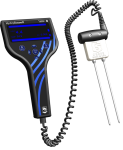This product is no longer available.

| 利用できるサービス | |
|---|---|
| 修理 | 対応 |
| キャリブレーション | 非対応 |
| フリーサポート | 対応 |
概要
The CS625 measures the volumetric water content from 0% to saturation. It is similar to our CS616 but is designed specifically for CR200(X) and CR300-series dataloggers. This reflectometer has a 0 to 3.3 V square wave frequency output that our CR300-series and CR200(X)-series dataloggers can measure.
続きを読む利点と特徴
- High accuracy and high precision
- Fast response time
- Designed for long-term unattended water content monitoring
- Probe rods can be inserted from the surface or buried at any orientation to the surface.
イメージ

詳細
The CS625 consists of two 30-cm-long stainless steel rods connected to a printed circuit board. The circuit board is encapsulated in epoxy, and a shielded four-conductor cable is connected to the circuit board to supply power, enable probe, and monitor the output.
The CS625 measures the volumetric water content of porous media (such as soil) using the time-domain measurement method; a reflectometer (cable tester) such as the TDR100 is not required. This method consists of the CS625 generating an electromagnetic pulse. The elapsed travel time and pulse reflection are then measured and used to calculate soil volumetric water content.
Response Characteristics
The signal propagating along the parallel rods of the CS625 is attenuated by free ions in the soil solution and conductive constituents of the soil mineral fraction. In most applications, the attenuation is not enough to affect the CS625 response to changing water content, and the response is well described by the standard calibration. However, in soil with relatively high soil electrical conductivity levels, compacted soils, or soils with high clay content, the calibration should be adjusted for the specific medium. Guidance for making these adjustments is provided in the operating manual.
仕様
| Measurements Made | Volumetric water content of porous media (such as soil) |
| Water Content Accuracy | ±2.5% VWC (using standard calibration with bulk EC of ≤ 0.5 dS m-1, bulk density of ≤ 1.55 g cm-3, and measurement range of 0% to 50% VWC) |
| Required Equipment | Measurement system |
| Soil Suitability | Long rods and lower frequency are well-suited for soft soil with low electrical conductivity (< 2 dS/m). |
| Rods | Not replaceable |
| Sensors | Not interchangeable |
| Operating Temperature Range | 0° to 70°C |
| Probe-to-Probe Variability | ±0.5% VWC in dry soil, ±1.5% VWC in typical saturated soil |
| Precision | 0.1% VWC |
| Resolution | 0.1% VWC |
| Output | 0 to 3.3 V square wave (with frequency dependent on water content) |
| Current Drain |
|
| Power Supply Voltage | 5 Vdc minimum; 18 Vdc maximum |
| Enable Voltage | 4 Vdc minimum; 18 Vdc maximum |
| Electromagnetic | CE compliant (Meets EN61326 requirements for protection against electrostatic discharge.) |
| Rod Spacing | 32 mm (1.3 in.) |
| Rod Diameter | 3.2 mm (0.13 in.) |
| Rod Length | 300 mm (11.8 in.) |
| Probe Head Dimensions | 85 x 63 x 18 mm (3.3 x 2.5 x 0.7 in.) |
| Cable Weight | 35 g per m (0.38 oz per ft) |
| Weight | 280 g (9.9 oz) without cable |
互換性
注意: 以下は代表的な互換性情報を示しています。互換性のある製品や互換性のない製品をすべて網羅したリストではありません。
Data Loggers
| 製品 | 互換性 | 注意 |
|---|---|---|
| CR1000 (リタイア) | ||
| CR200X (リタイア) | ||
| CR206X (リタイア) | ||
| CR211X (リタイア) | ||
| CR216X (リタイア) | ||
| CR295X (リタイア) | ||
| CR300 (リタイア) | ||
| CR3000 (リタイア) | ||
| CR310 | ||
| CR5000 (リタイア) | ||
| CR800 (リタイア) | ||
| CR850 (リタイア) | ||
| CR9000X (リタイア) |
互換性に関する追加情報
RF Considerations
The RF emissions are below FCC and EU limits as specified in EN61326 if the CS625 is enabled less than 0.6 ms, and measurements are made less frequently than once a second. External RF sources can also affect the CS625 operation. Consequently, the CS625 should be located away from significant sources of RF such as ac power lines and motors.
Installation Tool
The CS650G makes inserting soil-water sensors easier in dense or rocky soils. This tool can be hammered into the soil with force that might damage the sensor if the CS650G were not used. It makes pilot holes into which the rods of the sensors can then be inserted. It replaces both the 14383 and 14384.
Data Logger Considerations
Each CS625 requires a single-ended input channel. A control port is used to enable one or more probes.
Note: A maximum of four CS625 probes can be measured by one CR200(X) datalogger. Valid channel options are analog channels 1 through 4.
よくある質問
CS625に関するよくある質問の数: 34
すべて展開すべて折りたたむ
-
300 m (1,000 ft).
-
Yes, as long as the data logger can detect a 0 to 3300 mV square wave over a frequency range of 29 to 67 kHz.
-
ロッドの切断は、ユーザー自身の責任でのみ行ってください。切断すると、プローブの再校正が必要になります。Campbell Scientific は、CS616 または CS625 を短くした場合の校正を提供していません。
ロッドが短い場合、プローブは機能しますが、土壌内のロッドの長さが総移動時間に与える影響が小さいため、精度が若干低下します。ただし、ロッドが短いプローブは、塩分の多い土壌でも機能します。
-
新しいサイトの土壌の種類が異なる場合は、土壌固有のキャリブレーションが必要になることがあります。 全体の電気伝導率が低い砂質または砂質ロームの土壌の場合、CS616 および CS625 の取扱説明書に記載されているキャリブレーション式が適切に機能します。
-
CS616 と CS625 は、サイズ、形状、機能が同じです。唯一の違いは出力信号です。CS616 は ±700 mV の矩形波出力を持ち、CS625 は 0 ~ 3300 mV の矩形波出力を持ちます。
CS625 は、負の電圧を測定できない CR200 シリーズおよび CR200X シリーズのデータロガーで使用するために設計されました。そのため、出力は信号全体を正の電圧範囲に保つように変更されました。
-
土壌固有の校正を実行する場合、CS616/CS625 は最大バルク電気伝導率が 5 dS/m の土壌で使用できます。
-
はい、ただし CS616/CS625 では土壌固有のキャリブレーションが必要です。泥炭の有機物含有量が高いため、CS616/CS625 の周期は CS616() CRBasic 命令および P138 Edlog 命令での使用範囲外になる可能性があります。その場合、CS616 および CS625 の取扱説明書に記載されているように、CRBasic PeriodAvg() 命令または Edlog P27 Period Average 命令を使用できます。
-
はい。水の誘電率は温度によって変化するため、CS616/CS625 周期は温度の上昇とともに減少し、温度の低下とともに増加します。さらに、土壌水溶液の電気伝導率は温度に依存するため、CS616/CS625 周期は温度の上昇とともに増加し、温度の低下とともに減少します。これら 2 つの反対の力の正味の効果は、土壌の質感と電気伝導率によって異なります。CS616 および CS625 の取扱説明書の温度補正式は、比較的電気伝導率の低い砂質ローム土を使用して作成されました。よりきめの細かい土壌や電気伝導率の高い土壌の場合、Campbell Scientific は土壌固有の温度補正式を推奨しています。
-
いいえ。出力は 21X または CR7 のパルス チャンネルで測定するには速すぎます。
-
廃棄物内の電気伝導率が 5 dS/m 未満で、プローブ ロッドと廃棄物の接触が良好であれば、CS616/CS625 は水分含有量の変化に予測どおりに反応するはずです。ただし、固形廃棄物の不均質性と変化する嵩密度により、校正は困難になります。
Privacy Policy Update
We've updated our privacy policy. 詳細はこちら
Cookie Consent
Update your cookie preferences. クッキーの設定を更新する



